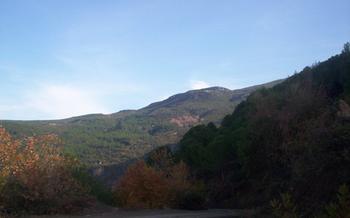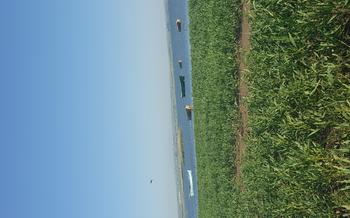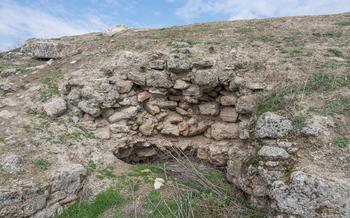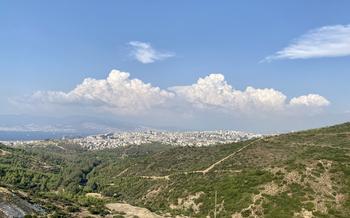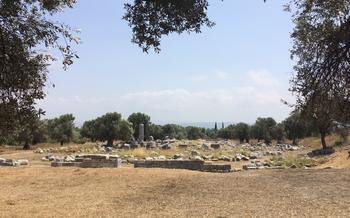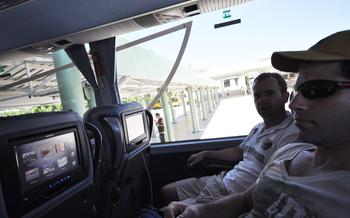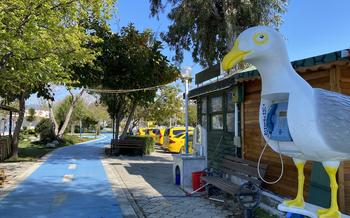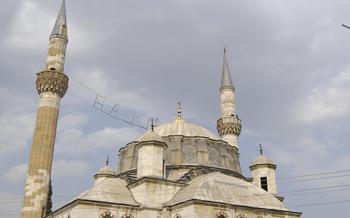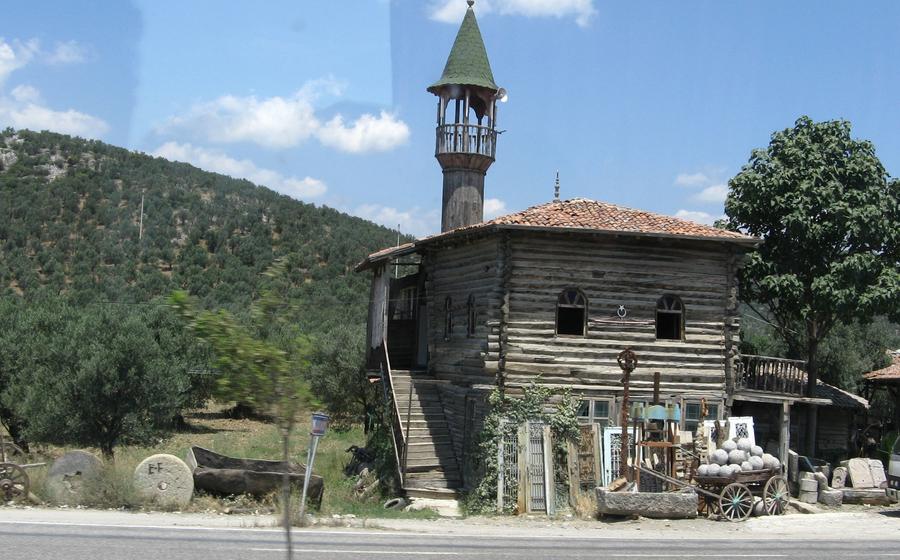
The Ancient City of Adramytteion
- Adramytteion: A Historical Gem
- Getting to Adramytteion:
- Exploring the City Walls
- Unearthing the Ancient Theater
- Discovering the Agora
- Exploring the Baths
- Witnessing the Temple of Apollo
- Strolling Through the Necropolis
- Visiting the Adramytteion Museum:
- Admiring the Byzantine Church
- Indulging in Local Delicacies
- Exploring the Natural Wonders
- Unveiling the Olive Oil Heritage
- Experiencing the Vibrant Culture
- Insider Tip: Unveiling Hidden Gems
Adramytteion: A Historical Gem
In the heart of Balıkesir, Turkey, lies the ancient city of Adramytteion, a testament to the rich history and cultural heritage of the region. Founded around the 7th century BC by Aeolian Greeks, Adramytteion flourished as a significant port city, serving as a hub for trade and cultural exchange between the Aegean Sea and the Anatolian hinterland.
Throughout its existence, Adramytteion played a pivotal role in the development of the region, becoming a prominent center of commerce, politics, and culture. The city's strategic location on the coast, coupled with its fertile agricultural lands, contributed to its prosperity and influence.
Archaeological excavations conducted in Adramytteion have unearthed a wealth of artifacts and ruins, shedding light on the city's vibrant past. Discoveries include well-preserved city walls, an impressive theater, a bustling agora, elaborate bathhouses, and a temple dedicated to the Greek god Apollo. These remnants provide a glimpse into the architectural prowess, religious practices, and daily life of the ancient inhabitants.
Adramytteion's connection to ancient civilizations is evident in its coinage, which features images of Greek deities and symbols of power. The city's coins were widely circulated throughout the region, indicating its economic and political significance. Furthermore, Adramytteion was mentioned in the writings of renowned ancient historians, such as Strabo and Pliny the Elder, further solidifying its place in the annals of history.
Getting to Adramytteion:
Adramytteion's strategic location makes it easily accessible from major cities in Turkey. The city of Balıkesir, situated approximately 100 kilometers away, serves as the primary gateway. Regular bus services connect Balıkesir to Adramytteion, offering a convenient and affordable transportation option. The journey takes around 2 hours, providing an opportunity to admire the picturesque countryside along the way.
Alternatively, visitors can opt for a scenic train ride from İzmir, a vibrant coastal city renowned for its historical charm. The train line offers breathtaking views of the Aegean Sea, passing through quaint villages and lush landscapes. The travel time from İzmir to Adramytteion is approximately 4 hours, allowing ample time to relax and soak in the beauty of the region.
To enhance your travel experience, consider renting a car. This provides the flexibility to explore Adramytteion and its surroundings at your own pace. Car rental agencies are available in both Balıkesir and İzmir, offering a range of vehicles to suit different needs and budgets.
When planning your journey, keep in mind the distance and travel time to Adramytteion. Allocate sufficient time to explore the ancient city thoroughly and immerse yourself in its rich history and cultural heritage.
Exploring the City Walls
The ancient city of Adramytteion was once a fortified settlement, protected by imposing city walls that stretched over 6 kilometers. These impressive fortifications, dating back to the Hellenistic period, stand as a testament to the city's strategic importance and defensive prowess.
The walls were constructed using large blocks of stone, carefully fitted together without the use of mortar. They featured a double curtain design, with an inner and outer wall separated by a walkway. The outer wall was reinforced with towers and bastions, providing additional protection against attackers.
Several gates, each adorned with intricate carvings and inscriptions, allowed access to the city. These gates, such as the monumental Gate of Pergamon, served as important checkpoints and defensive structures.
Visitors can explore the remnants of the city walls, which offer panoramic views of the surrounding countryside. The walls provide a glimpse into the city's architectural prowess and its ability to withstand sieges and invasions throughout its long history.
Unearthing the Ancient Theater
In the heart of Adramytteion lies one of its most impressive remnants - the ancient theater, a testament to the city's cultural and entertainment legacy. Constructed during the Hellenistic period, the theater holds a significant place in the city's history. With a seating capacity that could accommodate thousands of spectators, it hosted a variety of performances, from theatrical productions to musical concerts.
The theater's architectural design showcases the ingenuity of ancient engineers. Its tiers of seating rise in a semi-circular formation, providing excellent acoustics and unobstructed views for the audience. The stage area, adorned with intricate reliefs and sculptures, served as a backdrop for the performances.
Over the centuries, the theater has undergone restoration efforts aimed at preserving its grandeur. While some parts of the structure remain in ruins, the overall layout and design are still discernible. Visitors can wander through the theater, imagining the vibrant atmosphere of ancient performances and the stories that unfolded on its stage.
Currently, the ancient theater stands as a symbol of Adramytteion's rich cultural heritage and serves as a venue for occasional events and performances, allowing visitors to experience a glimpse of the city's ancient theatrical traditions.
Discovering the Agora
In the heart of ancient Adramytteion, the agora served as a vibrant marketplace and social hub. As you step into this bustling center of commerce, imagine the lively atmosphere that once filled the air. Merchants from across the region gathered here to trade goods and services, exchanging everything from agricultural products to imported luxuries.
The agora was a labyrinth of narrow streets lined with shops and stalls. Artisans displayed their handmade crafts, while traders from distant lands showcased exotic wares brought by ship from faraway shores. The air was filled with the sounds of haggling, the clinking of coins, and the hum of conversation.
Beyond the commercial activities, the agora held great social and political significance. It was a place where citizens met to discuss important issues, make decisions, and celebrate religious festivals. Public buildings, such as the bouleuterion (council chamber) and the prytaneion (government building), were located within the agora, emphasizing its role as the administrative center of the city.
Today, the ruins of the agora offer a glimpse into this bustling marketplace. While time and earthquakes have taken their toll, the foundations of shops and stalls are still visible, along with remnants of public buildings. As you wander through the ancient agora, let your imagination transport you back to a time when Adramytteion was a thriving port city, and the agora was the beating heart of its economy and social life.
Exploring the Baths
In the heart of ancient Adramytteion, a remarkable complex of baths once stood as a testament to the city's opulence and appreciation for personal hygiene. These elaborate bathhouses, known as thermae, were not mere places of ablution but also served as social and cultural hubs.
Step inside these well-preserved ruins and marvel at the intricate layout and impressive engineering. The baths were divided into distinct sections, each serving a specific purpose. The frigidarium, or cold room, welcomed visitors with a refreshing plunge into chilly waters. The tepidarium, or warm room, offered a gradual transition to the scorching temperatures of the caldarium, or hot room. Here, bathers could relax and cleanse in steaming pools, surrounded by intricate mosaics and decorative elements.
Beyond their practical function, the baths held deep cultural significance. Bathing rituals were an integral part of ancient Greek and Roman societies, providing opportunities for socialization, relaxation, and rejuvenation. In Adramytteion, the baths were not only a place to cleanse the body but also to engage in philosophical discussions, conduct business, and forge social connections.
Today, the ruins of the baths stand as a testament to the ingenuity and artistry of the ancient world. As you wander through the complex, imagine the bustling crowds that once filled these spaces, seeking solace, rejuvenation, and a sense of community. The baths at Adramytteion offer a glimpse into the daily lives and cultural practices of a bygone era, inviting you to immerse yourself in the rich history of this ancient city.
Witnessing the Temple of Apollo
Among the ruins of Adramytteion, one of the most significant structures is the Temple of Apollo, a testament to the city's deep religious and cultural heritage. Dedicated to the Greek god Apollo, this temple once stood as a majestic symbol of worship and devotion.
Built in the classical architectural style, the Temple of Apollo featured intricate carvings, elegant columns, and a grand facade that commanded respect and awe. The temple's interior was adorned with statues, altars, and religious artifacts, creating an atmosphere of reverence and spirituality.
In ancient times, the Temple of Apollo served as a central location for religious rituals, ceremonies, and festivals. Devotees would gather to offer prayers, sacrifices, and libations to Apollo, seeking his favor and protection. The temple's priests played a crucial role in interpreting oracles and guiding the spiritual lives of the community.
Today, visitors can explore the remains of the Temple of Apollo and marvel at its enduring legacy. The temple's foundations, columns, and architectural fragments offer a glimpse into the grandeur of this sacred site. Ongoing archaeological work continues to uncover new insights into the temple's history and significance, shedding light on the religious beliefs and practices of ancient Adramytteion.
Strolling Through the Necropolis
Just outside the city walls of Adramytteion lies an extensive necropolis, a testament to the city's rich history and funerary practices. The cemetery is a treasure trove of ancient tombs, each offering a glimpse into the lives and beliefs of the city's inhabitants.
The necropolis features a diverse array of tombs, from simple earthen mounds to elaborate stone structures. Some tombs are adorned with intricate carvings and inscriptions, providing valuable insights into the identities and social status of the deceased. Visitors can explore various types of burials, including inhumation and cremation, and learn about the rituals and customs associated with death and the afterlife in ancient Adramytteion.
Among the notable tombs in the necropolis is the "Tomb of the Athlete". This well-preserved structure features a relief depicting an athlete engaged in a sporting event, suggesting the deceased's prowess and passion for physical competition. Another remarkable tomb is the "Family Tomb", which houses the remains of an entire family, showcasing the strong bonds and familial ties that existed within the ancient community.
Exploring the necropolis is a unique and thought-provoking experience that allows visitors to connect with the past and gain a deeper understanding of the lives and customs of the people who once called Adramytteion home. As you wander among the ancient tombs, you can't help but feel a sense of awe and wonder at the rich history that surrounds you.
Visiting the Adramytteion Museum:
Adramytteion Museum stands as a testament to the rich history and cultural heritage of the ancient city. Within its walls, visitors embark on a journey through time, exploring the diverse facets of Adramytteion's past. The museum's exhibits showcase a remarkable collection of artifacts unearthed during archaeological excavations, shedding light on the city's development, daily life, and artistic achievements.
The museum's galleries are a treasure trove of ancient pottery, sculptures, coins, and inscriptions. These artifacts provide valuable insights into the city's trade relations, religious practices, and administrative systems. Visitors can marvel at the intricate designs of ceramic vessels, admire the finely crafted marble statues, and decipher the stories inscribed on ancient coins.
Interactive displays and educational programs enhance the museum experience, bringing history to life for visitors of all ages. Through multimedia presentations, visitors can witness the construction of the ancient city's fortifications, experience the bustling atmosphere of the agora, and learn about the religious rituals performed in the temple of Apollo.
The Adramytteion Museum is not merely a repository of artifacts; it is a gateway to understanding the soul of this ancient city. By immersing themselves in the museum's exhibits, visitors gain a deeper appreciation for the rich cultural legacy that continues to shape the identity of Balıkesir.
Admiring the Byzantine Church
Amidst the ruins of ancient Adramytteion, the remnants of a once-magnificent Byzantine church stand as a testament to the city's rich religious and cultural heritage. This architectural gem, dating back to the 5th or 6th century AD, offers a glimpse into the grandeur of Byzantine artistry and engineering.
Despite the ravages of time and natural disasters, the church's imposing structure still evokes awe and admiration. Its intricate stonework, graceful arches, and elaborate decorative elements hint at the grandeur it once possessed. The church's central dome, a defining feature of Byzantine architecture, collapsed centuries ago, but its remnants still convey its impressive scale.
The church holds immense historical significance, having served as a spiritual center for the Christian community of Adramytteion during the Byzantine era. It likely played a pivotal role in the religious and social life of the city, hosting liturgical services, celebrations, and community gatherings.
Preservation and restoration efforts are ongoing to safeguard this valuable heritage site. While the church is not fully accessible to visitors due to safety concerns, its imposing presence and historical allure make it a must-see attraction for anyone interested in the rich tapestry of civilizations that have shaped Adramytteion.
Indulging in Local Delicacies
Culinary temptations abound in the Balıkesir region, where the flavors of Turkish and Aegean cuisine harmoniously blend. Start your gastronomic journey with zeytinyağlı dishes, a hallmark of Aegean cuisine, featuring fresh vegetables, herbs, and an abundance of olive oil. Sample kelle söğüş, a refreshing salad made with lamb's head meat, or savor the succulent midye dolma, tender mussels stuffed with rice and herbs.
Seafood lovers will delight in the region's bounty of freshly caught fish, grilled to perfection and seasoned with aromatic herbs. Don't miss the local specialty, çipura güveç, a flavorful sea bass casserole baked in a traditional clay pot.
For a taste of traditional Turkish cuisine, try the mouthwatering keşkek, a hearty dish of shredded wheat, lamb, and chickpeas, or indulge in the savory mantı, delicate dumplings filled with minced meat and topped with yogurt and garlic sauce.
No meal is complete without a sweet treat. Balıkesir's cevizli lokum, a delight made with walnuts and Turkish delight, is a must-try. And for a unique dessert experience, sample kabak tatlısı, a sweet pumpkin dessert topped with kaymak, a rich clotted cream.
Local markets and restaurants offer a vibrant culinary scene, allowing you to immerse yourself in the region's gastronomic traditions. Engage with the friendly locals, discover hidden gems off the beaten path, and savor the flavors that make Balıkesir a culinary paradise.
Exploring the Natural Wonders
Beyond the ancient ruins, Adramytteion offers a wealth of natural wonders that complement its rich history. The region boasts breathtaking landscapes, inviting outdoor enthusiasts to embark on a journey through nature's marvels.
Lace-up your hiking boots and traverse scenic trails that wind through picturesque valleys, leading to hidden waterfalls and panoramic viewpoints. Capture the beauty of the surrounding landscapes, with every click of your camera revealing a new natural masterpiece.
For birdwatching enthusiasts, Adramytteion is a haven of diverse avian species. Observe the graceful flight of eagles soaring above the cliffs, or spot the vibrant colors of migratory birds that frequent the region.
Nature reserves, such as the Manyas Bird Paradise, provide a sanctuary for an array of wildlife. Stroll along wooden walkways, immersing yourself in the tranquil ambiance as you encounter various bird species, including the majestic flamingos.
Enhance your Adramytteion experience by combining history and nature seamlessly. Discover ancient ruins amidst serene natural settings, where the whispers of the past blend harmoniously with the symphony of nature.
Unveiling the Olive Oil Heritage
The region surrounding Adramytteion is renowned for its exceptional olive oil production, a tradition deeply rooted in its history and culture. As you explore the countryside, you'll encounter vast olive groves, where rows upon rows of silvery-green trees stretch towards the horizon. These groves are a testament to the region's agricultural heritage and the dedication of local farmers to producing the finest quality olive oil.
Take the opportunity to visit one of these groves and learn about the cultivation techniques employed by local farmers. Observe how they carefully tend to their trees, pruning, and nurturing them to ensure a bountiful harvest. You'll gain insights into the intricate process of olive oil production, from harvesting the olives at their peak ripeness to extracting the precious oil through traditional or modern methods.
Once you've witnessed the dedication that goes into producing Adramytteion olive oil, you'll truly appreciate its exceptional taste and aroma. Sample and purchase locally-made olive oil products, including bottles of golden-green oil, infused oils with herbs and spices, and even olive oil-based cosmetics.
For a truly immersive experience, participate in a culinary workshop or tasting session. Learn how to incorporate olive oil into your cooking, enhancing the flavors of your dishes with this liquid gold.
Insider Tip: For an authentic taste of the region's olive oil heritage, visit the local markets. Here, you'll find stalls selling freshly pressed olive oil, olives of various varieties, and other locally-produced delicacies.
Experiencing the Vibrant Culture
Balıkesir, where Adramytteion is situated, pulsates with a vibrant cultural tapestry. Throughout the year, festivals, celebrations, and cultural events paint the town in a kaleidoscope of colors and sounds. Immerse yourself in traditional Turkish music, where soulful melodies intertwine with rhythmic beats, transporting you to a realm of auditory enchantment. Witness the grace and agility of traditional Turkish dance performances, where mesmerizing movements narrate tales of history and heritage.
Explore the local art scene, where talented artisans showcase their mastery in intricate handicrafts, pottery, and textiles. Engage with the friendly locals, eager to share stories, anecdotes, and insights into their way of life. Embrace the warmth and hospitality of the Turkish people, renowned for their welcoming nature and generosity of spirit. Allow yourself to be swept away by the infectious energy of Balıkesir's vibrant culture, creating memories that will linger long after your visit.
Insider Tip: Unveiling Hidden Gems
While exploring Adramytteion, don't miss the opportunity to venture beyond the main attractions and discover hidden gems that offer a unique glimpse into the region's past. Take a short drive to the nearby village of Altınoluk, where you'll find the well-preserved remains of an ancient Roman aqueduct. Admire its impressive engineering and imagine the vital role it played in supplying water to the city centuries ago.
For a truly immersive experience, embark on a guided tour with a local historian or archaeologist. They will lead you to lesser-known ruins, forgotten temples, and ancient quarries, providing insights into the rich history of Adramytteion. These experts can also recommend local artisans and craftsmen who keep traditional techniques alive, showcasing the region's vibrant cultural heritage.
To fully embrace the local way of life, visit the weekly markets in nearby towns. These bustling marketplaces offer a kaleidoscope of colors, aromas, and flavors. Browse through stalls selling fresh produce, handmade crafts, and local delicacies. Engage with friendly vendors and learn about their products and traditions.
Remember to respect local customs and dress modestly when visiting religious sites or conservative areas. Striking up conversations with locals is a great way to gain insights into their daily lives and perspectives. Their recommendations for hidden gems and authentic experiences can lead you to unforgettable moments that will make your journey to Adramytteion truly special.
